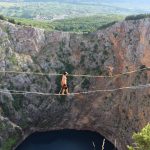The Blue Lake phenomenon in Imotski has caught the eyes of everyone in Croatia as it swapped its rather deep blue color for a lighter hue after abundant rain and a sudden flow of water from underground springs.
This phenomenon even attracted the attention of a team of experts at the initiative of the Public Institution for the Management of Protected Natural Values in the Split-Dalmatia County “Sea and Karst”, who have tried to scientifically prove the rapid change of the lake, as well as the causes and consequences of such changes, reports Slobodna Dalmacija on May 13, 2019.
https://www.youtube.com/watch?v=v=SfuT2S1LE5E
“The Blue Lake seldom changes color and is mostly associated with a sudden rise in water levels. At the bottom of the Blue Lake, there are estavelles, cavities in the karst massif, which may have an abyss and springs depending on the surrounding groundwater level.
The rapid growth of water levels is the result of activated estavelles, and this is in the role of strong springs. The powerful flow of water through underground karst canals increases the dissolving of minerals that can be found in the predominantly widespread limestone rocks.
The first results of water analysis from the Blue Lake indicate an increase in calcium carbonate (CaCO3), which is derived from limestone. Calcium carbonate in rocks appears as mineral calcite which is white in color, and because of its increased water concentration, it changes the way water absorbs and reflects the light.
Thus, on this occasion, the lake water takes on an unusual turquoise color, and the Blue Lake, with its beauty and unparalleled tinge of blue has again captured the attention of Imotski citizens and their guests,” said Branimir Jukić, a senior expert from the “Sea and Karst” study, adding that the microbiological analysis of the algae excluded the flowering process as a cause of color change.
The bright turquoise color of the lake has attracted many visitors, and it may not be going anywhere soon thanks to increased groundwater flow and rising water levels in the lake.
The current depth of the lake is 36 meters, and this aesthetic anomaly has not affected the quality and purity of lake water.
The team of experts who investigated this phenomenon includes Dr. Sc. Ivo Andrić from the Faculty of Civil Engineering, Architecture and Geodesy in Split, prof. Dr. Sc. Nenad Buzjak and Ph.D. Marija Gligora Udovič from the Zagreb Faculty of Natural Sciences and Mathematics, Ph.D. Ana Kovačić from the Institute of Public Health SDŽ, and dr. Sc. Milan Čanković from the Institute for Marine and Environmental Research at the Ruđer Bošković Institute, along with “Sea and Karst.”
HPD “Imotski” also regularly visited the Blue Lake, took water samples and submitted them for analysis in laboratories in Split and Zagreb. The lake water analysis continues to be carried out at the PMF in Zagreb and the Ruđer Bošković Institute.
To read more about lifestyle in Croatia, follow TCN’s dedicated page.










